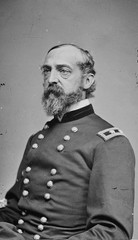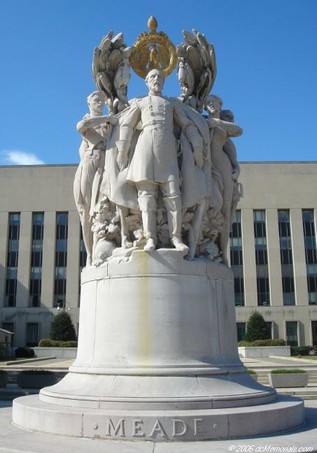Major General George Gordon Meade Memorial
Introduction
Text-to-speech Audio
Images
Major General George G. Meade (Library of Congress)

The memorial to General George Gordon Meade

Backstory and Context
Text-to-speech Audio
George Meade was born in Cadiz, Spain while his family was stationed there during his father’s time with the United States Navy. After his father passed away in 1828, the family returned to the United States and settled in Pennsylvania. Meade received an appointment to the United States Military Academy at West Point where he graduated nineteenth out of fifty-six cadets in 1835.
Meade left the army in 1836 and began a civil engineering career working for the U.S. War Department and also working for railroad companies. Meade re-entered the army in 1842 and served in the Mexican-American War. After the war, he served in the Army corps of Topographical Engineers.
In 1861, George Meade was promoted to Brigadier General and placed in command of Pennsylvania volunteers owing to the recommendation of the Pennsylvania governor. Meade’s volunteers served during the peninsula campaign, the Second Battle of Bull Run, the Battle of Antietam, and the Battle of South Mountain during the Maryland Campaign. He was promoted to Major General after the Battle of Fredericksburg and was commander of the V Corps of the Army of the Potomac during the Union defeat at Chancellorsville. After Joseph Hooker resigned as commander of the Army of the Potomac, President Lincoln unexpectedly promoted Meade to the position.
Meade’s new command clashed with General Robert E Lee’s forces at the Battle of Gettysburg between July 1st and July 3rd. Using brilliant defensive positions, Meade defeated Lee’s Army after taking heavy casualties over the three days of fighting. However, President Lincoln was alarmed to find that Meade did not give chase to Lee’s retreating army and destroy it. Meade offered his resignation but Lincoln refused, acknowledging Meade's value as a commander.
Meade served as the commander of the Army of the Potomac through the rest of the war, but was overshadowed by the promotion of Lieutenant General Ulysses S Grant to general-in-chief of the army. Following the Civil War, Meade remained in the army and served as commander of the Division of the Atlantic. He served as governor of the Third Military District during the early years of Reconstruction. From 1866 until his death, Meade was Commissioner of Fairmont Park in Philadelphia.
The memorial to George Meade was commissioned by the State of Pennsylvania in 1913. Charles Grafly, a native Pennsylvanian, designed the monument which was dedicated at Union Square in October 1927. President Calvin Coolidge, Governor John Stuchell Fischer, Secretary of the Treasury Andrew N Mellon, and Senator Simeon D. Fess were in attendance.
The National Park Service removed the piece in 1969 and was put into storage during the construction of the reflecting pool. In 1983, it was rededicated in front of the E. Barrett Prettyman Federal Courthouse on Pennsylvania Avenue and 3rd Street. Six allegorical figures circle the memorial to General Meade. These figures are Loyalty, Chivalry, Fame, Progress, Military Courage, and Energy. The top of the memorial has the State Seal of Pennsylvania. The back of the statue depicts a scene of war.
Sources
"George G. Meade." Civil War Trust. Accessed April 01, 2017. http://www.civilwar.org/education/history/biographies/george-meade.html.
History.com Staff. "George G. Meade." History.com. 2009. Accessed April 01, 2017. http://www.history.com/topics/american-civil-war/george-g-meade.
